All Exams >
Biotechnology Engineering (BT) >
Mock Test Series of IIT JAM Biotechnology 2026 >
All Questions
All questions of Genetics for Biotechnology Engineering (BT) Exam
In a Drosophila, three recessive mutations can lead to white eyes, yellow body and vestigial wings. A heterozygous fly is crossed with a fly recessive for all these mutations. Using the following data, the distance between the gene for wing shape and eye color would be ________cM. (Answer upto one point after decimal)
Correct answer is between '17.1,17.5'. Can you explain this answer?
In a Drosophila, three recessive mutations can lead to white eyes, yellow body and vestigial wings. A heterozygous fly is crossed with a fly recessive for all these mutations. Using the following data, the distance between the gene for wing shape and eye color would be ________cM. (Answer upto one point after decimal)
|
|
Vedika Singh answered |
q2 = 0.04. Then, q = 0.2. p = 1-q = 0.8.
Frequency of heterozygotes will be 2pq = 2(0.8)(0.2) = 0.32
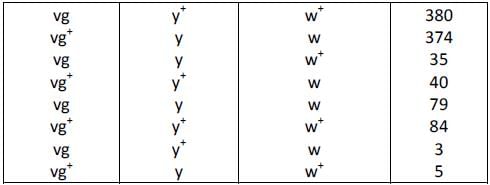
The gene w is in the middle. Distance between vg and w will be = Number of SCOs (79+84) + number of DCOs(8) / 1000 = 17.1 cM
Frequency of heterozygotes will be 2pq = 2(0.8)(0.2) = 0.32

The gene w is in the middle. Distance between vg and w will be = Number of SCOs (79+84) + number of DCOs(8) / 1000 = 17.1 cM
A population is in Hardy-Weinberg equilibrium. If the frequency of a recessive allele for a certain hereditary trait is 0.30. In the next generation percentage of individuals expected to show the dominant trait would be_____%. (Answer in integer)
Correct answer is '49'. Can you explain this answer?
A population is in Hardy-Weinberg equilibrium. If the frequency of a recessive allele for a certain hereditary trait is 0.30. In the next generation percentage of individuals expected to show the dominant trait would be_____%. (Answer in integer)

|
Bijoy Patel answered |
q = 0.30
p = 1–q = 0.70
p2 = 0.70 * 0.70 = 0.49
% of individuals with p2 = 0.49 * 100 = 49%
p = 1–q = 0.70
p2 = 0.70 * 0.70 = 0.49
% of individuals with p2 = 0.49 * 100 = 49%
In humans, which of the following is a primary determinant of maleness?- a)Absence of an X chromosome
- b)Presence of a Y chromosome
- c)Presence of both X and Y chromosomes
- d)The ratio of X to Y chromosomes should be 1 : 1
Correct answer is option 'B'. Can you explain this answer?
In humans, which of the following is a primary determinant of maleness?
a)
Absence of an X chromosome
b)
Presence of a Y chromosome
c)
Presence of both X and Y chromosomes
d)
The ratio of X to Y chromosomes should be 1 : 1

|
Varun Yadav answered |
In humans, the presence of a Y chromosome results in formation of testis. If the Y chromosome is absent, then ovaries are formed.
Which of the following is true for polyploidy?- a)Modern wheat is a polyploidy
- b)Polyploids are rarely sterile
- c)Polyploidy is rare in animals because it interferes with their sex determination mechanism
- d)It makes the cell size large because the number of chromosomes increase in the nucleus.
Correct answer is option 'A,C,D'. Can you explain this answer?
Which of the following is true for polyploidy?
a)
Modern wheat is a polyploidy
b)
Polyploids are rarely sterile
c)
Polyploidy is rare in animals because it interferes with their sex determination mechanism
d)
It makes the cell size large because the number of chromosomes increase in the nucleus.

|
Anirban Kapoor answered |
Polyploids are sterile because of irregular segregation of chromosomes during meiosis. It may result in aneuploid gametes. The zygotes obtained always die and this inviability explains the sterility of polyploid organisms.
Which of the following can be said about continuous traits? - a)The environment influences the phenotype.
- b)Mendel's laws can apply to these traits.
- c)Two or more genes are often involved.
- d)Polygenes are all present on the same chromosome.
Correct answer is option 'A,C'. Can you explain this answer?
Which of the following can be said about continuous traits?
a)
The environment influences the phenotype.
b)
Mendel's laws can apply to these traits.
c)
Two or more genes are often involved.
d)
Polygenes are all present on the same chromosome.

|
Mahi Dasgupta answered |
Mendel’s laws do not apply to these traits as several genes are responsible for a single trait and it is impossible to track each on them on the basis of Mendel’s principles. These genes may or may not necessarily be present on the same chromosome. The genotype as well as the environment influence these traits.
Albinism is a recessive condition in humans. If 85% of a population is albino, then the allele frequency of the dominant allele will be (Answer upto three decimal points) __________
Correct answer is '0.079'. Can you explain this answer?
Albinism is a recessive condition in humans. If 85% of a population is albino, then the allele frequency of the dominant allele will be (Answer upto three decimal points) __________

|
Kiran Pillai answered |
Introduction:
In order to understand the allele frequency of the dominant allele in a population with a recessive condition like albinism, we need to consider the principles of Mendelian genetics and the Hardy-Weinberg equilibrium.
Explanation:
1. Understanding Albinism:
- Albinism is a recessive condition, which means that an individual needs to inherit two copies of the recessive allele (aa) in order to express the trait.
- A dominant allele (A) is responsible for the normal pigmentation in individuals without albinism.
2. Population Frequency of Albinism:
- The question states that 85% of the population is albino. Since albinism is a recessive condition, the albino individuals must be homozygous recessive (aa).
- Let's assume that the frequency of the homozygous recessive individuals (aa) is represented by q.
3. Calculating the Frequency of the Recessive Allele:
- According to the Hardy-Weinberg equilibrium, the frequency of the recessive allele (a) can be determined using the equation: q^2 = 0.85
- Taking the square root of 0.85, we find that q ≈ 0.922.
- Since q represents the frequency of the recessive allele, the frequency of the dominant allele (A) can be calculated as p = 1 - q.
- Therefore, the frequency of the dominant allele is p ≈ 1 - 0.922 ≈ 0.078.
4. Allele Frequency:
- The allele frequency represents the proportion of a specific allele in a population.
- In this case, the frequency of the dominant allele (A) is approximately 0.078, which can be rounded to 0.079 as the correct answer.
Conclusion:
The allele frequency of the dominant allele in a population with 85% albino individuals can be calculated using the Hardy-Weinberg equilibrium. In this case, the frequency of the dominant allele is approximately 0.079.
In order to understand the allele frequency of the dominant allele in a population with a recessive condition like albinism, we need to consider the principles of Mendelian genetics and the Hardy-Weinberg equilibrium.
Explanation:
1. Understanding Albinism:
- Albinism is a recessive condition, which means that an individual needs to inherit two copies of the recessive allele (aa) in order to express the trait.
- A dominant allele (A) is responsible for the normal pigmentation in individuals without albinism.
2. Population Frequency of Albinism:
- The question states that 85% of the population is albino. Since albinism is a recessive condition, the albino individuals must be homozygous recessive (aa).
- Let's assume that the frequency of the homozygous recessive individuals (aa) is represented by q.
3. Calculating the Frequency of the Recessive Allele:
- According to the Hardy-Weinberg equilibrium, the frequency of the recessive allele (a) can be determined using the equation: q^2 = 0.85
- Taking the square root of 0.85, we find that q ≈ 0.922.
- Since q represents the frequency of the recessive allele, the frequency of the dominant allele (A) can be calculated as p = 1 - q.
- Therefore, the frequency of the dominant allele is p ≈ 1 - 0.922 ≈ 0.078.
4. Allele Frequency:
- The allele frequency represents the proportion of a specific allele in a population.
- In this case, the frequency of the dominant allele (A) is approximately 0.078, which can be rounded to 0.079 as the correct answer.
Conclusion:
The allele frequency of the dominant allele in a population with 85% albino individuals can be calculated using the Hardy-Weinberg equilibrium. In this case, the frequency of the dominant allele is approximately 0.079.
A plant of the genotype AaBb is selfed. The two genes are linked and are 50 map units apart. What proportion of the progeny will have the genotype aabb?- a)1/2
- b)1/4
- c)1/8
- d)1/16
Correct answer is option 'D'. Can you explain this answer?
A plant of the genotype AaBb is selfed. The two genes are linked and are 50 map units apart. What proportion of the progeny will have the genotype aabb?
a)
1/2
b)
1/4
c)
1/8
d)
1/16

|
Isha Bose answered |
Given that the genes A and B are linked by 50 map unit apart. So the frequency of recombinant is 50%. That is crossing the AaBb with aabb will results 50% recombinants and 50% parental gametes (AB : aB : Ab : ab : : 1 : 1 : 1 : 1). Thus the genes will seggregate by independent assortment as proposed by Mendel.
According to Mendelian dihybrid cross selfing of AaBb will result in aabbprogeneis in the ratio of 1/16.
According to Mendelian dihybrid cross selfing of AaBb will result in aabbprogeneis in the ratio of 1/16.
In a population of insects, the color brown (B) is dominant over the color white (b). 4% of all insects are white. The frequency of heterozygous individuals would be _________ (Answer upto two point after decimal)
Correct answer is between '0.32,0.35'. Can you explain this answer?
In a population of insects, the color brown (B) is dominant over the color white (b). 4% of all insects are white. The frequency of heterozygous individuals would be _________ (Answer upto two point after decimal)

|
Kiran Pillai answered |
q2 = 0.04. Then, q = 0.2. p = 1-q = 0.8.
Frequency of heterozygotes will be 2pq = 2(0.8)(0.2) = 0.32
Frequency of heterozygotes will be 2pq = 2(0.8)(0.2) = 0.32
Which of the following is true for two genes undergoing independent assortment?- a)The genes are located on different chromosomes or they are located far apart on the same chromosome.
- b)The expression of one gene does not affect the expression of the other.
- c)They are located atleast 10cM apart on the same chromosome.
- d)Crossing over does not occur between the genes.
Correct answer is option 'A'. Can you explain this answer?
Which of the following is true for two genes undergoing independent assortment?
a)
The genes are located on different chromosomes or they are located far apart on the same chromosome.
b)
The expression of one gene does not affect the expression of the other.
c)
They are located atleast 10cM apart on the same chromosome.
d)
Crossing over does not occur between the genes.

|
Bhavana Pillai answered |
Only those genes which are located on different chromosomes undergo independent assortment. Those genes which are located on the same chromosome are said to represent a linkage group and are inherited together. They experience independent assortment only if they are located far apart and crossing over can occur between them.
Two heterozygous individuals having the genotype AaBb are crossed with each other. The probability of having a baby with genotype AaBb is _______ (Answer upto two decimal points)
Correct answer is '0.25'. Can you explain this answer?
Two heterozygous individuals having the genotype AaBb are crossed with each other. The probability of having a baby with genotype AaBb is _______ (Answer upto two decimal points)
|
|
Pooja Choudhury answered |
When AaBb and AaBb are crossed with each other, the probability of getting a genotype Aa will be ½. Same way the probability of getting genotype Bb will be ½.
Using the product rule, to get an individual with both Aa and Bb, we will multiply the individual probabilities. This gives us ¼ as the probability of getting a baby with genotype AaBb.
Using the product rule, to get an individual with both Aa and Bb, we will multiply the individual probabilities. This gives us ¼ as the probability of getting a baby with genotype AaBb.
Pigmentation in moth is maternally affected where a+ is the allele for pigmentation. A mother with genotype a+ /a and a father with genotype aa will produce a progeny which is- a)All unpigmented at the larval stage
- b)All pigmented at the larval stage
- c)Half of the larvae are pigmented at the larval stage
- d)Three-fourths of the larvae are pigmented at the larval stage
Correct answer is option 'B'. Can you explain this answer?
Pigmentation in moth is maternally affected where a+ is the allele for pigmentation. A mother with genotype a+ /a and a father with genotype aa will produce a progeny which is
a)
All unpigmented at the larval stage
b)
All pigmented at the larval stage
c)
Half of the larvae are pigmented at the larval stage
d)
Three-fourths of the larvae are pigmented at the larval stage

|
Shail Ghoshal answered |
Pigmentation in moth is the example of the maternal effect in which the cytoplasm and genotype of the mother affect the phenotype of the progeny as mother genotype is a+/a that’s why all the progenies will be pigmented at larval stages
Which of the following is correct for a species that has a chromosome number 2n = 20?- a)The gametes will contain 10 chromosomes
- b)The somatic cells will contain 20 chromosomes
- c)The gametes will contain 20 chromosomes
- d)The somatic cells contain 20 different types of chromosomes
Correct answer is option 'A,B'. Can you explain this answer?
Which of the following is correct for a species that has a chromosome number 2n = 20?
a)
The gametes will contain 10 chromosomes
b)
The somatic cells will contain 20 chromosomes
c)
The gametes will contain 20 chromosomes
d)
The somatic cells contain 20 different types of chromosomes

|
Saanvi Roy answered |
The species is a diploid and the gametes would be haploid and contain n number of chromosomes i.e. 10. The somatic cells would contain 2n number of chromosomes i.e 20. Only 10 different types of chromosomes are present in the species.
Which of the following can result in Down Syndrome in an individual?- a)Non-disjunction of chromosome 21 prior to or at conception.
- b)Translocation of a part of chromosome 21 to chromosome 14
- c)Paracentric inversion in chromosome 21 leading to formation of a dicentric bridge
- d)Deletion of a gene on chromosome 21
Correct answer is option 'A,B'. Can you explain this answer?
Which of the following can result in Down Syndrome in an individual?
a)
Non-disjunction of chromosome 21 prior to or at conception.
b)
Translocation of a part of chromosome 21 to chromosome 14
c)
Paracentric inversion in chromosome 21 leading to formation of a dicentric bridge
d)
Deletion of a gene on chromosome 21

|
Tanishq Goyal answered |
Non-disjunction of chromosome 21 can lead to trisomy of 21 after fertilization with a haploid gamete. This results in Down Syndrome. When a part of chromosome 21 cuts off and gets translocated on chromosome 14, it gives a trisomy like effect when this 14/21 chromosome gets segregated into a gamete and is fertilized. So, both translocation and non-disjunction result in Down Syndrome.
Which of the following are true for Karyotyping?- a)It determines ploidy of the cells.
- b)It helps to diagnose disorders such as cystic fibrosis and Huntington disorder.
- c)Extra or missing chromosomes can be identified
- d)Cells need to be harvested at metaphase
Correct answer is option 'A,C,D'. Can you explain this answer?
Which of the following are true for Karyotyping?
a)
It determines ploidy of the cells.
b)
It helps to diagnose disorders such as cystic fibrosis and Huntington disorder.
c)
Extra or missing chromosomes can be identified
d)
Cells need to be harvested at metaphase

|
Tejas Goyal answered |
The counting and identification of chromosomes in the karyotype of an individual can diagnose aneuploidies, diseases caused by an alteration in the number of chromosomes in relation to the normal number in the species. It does not detect diseases caused due to mutations.
In a flock of sheep, 9% of the population has black wool and 91% has white wool. The percent of population is heterozygous for this trait if black wool is recessive and the population is in Hardy Weinberg Equilibrium will be ________% (Answer in integer)
Correct answer is '42'. Can you explain this answer?
In a flock of sheep, 9% of the population has black wool and 91% has white wool. The percent of population is heterozygous for this trait if black wool is recessive and the population is in Hardy Weinberg Equilibrium will be ________% (Answer in integer)

|
Bijoy Patel answered |
q2 = 0.09, then q = 0.3
p = 1-q = 0.7
heterozygous population = 2pq = 2*0.7*0.3 = 42%
p = 1-q = 0.7
heterozygous population = 2pq = 2*0.7*0.3 = 42%
A black Labrador homozygous for the dominant alleles (BBEE) is crossed with a yellow Labrador homozygous for the recessive alleles (bbee). On inter-crossing the F1, the F2 progeny was obtained in the following ratio, 9 Black : 3 Brown : 4 Yellow.This is an example of - a)Recessive epistasis where e allele is epistatic to B and b
- b)Dominant epistasis where E allele is epistatic to B and b
- c)Recessive epistasis where e allele is epistatic to E
- d)Complementary epistasis where b allele is epistatic
Correct answer is option 'A'. Can you explain this answer?
A black Labrador homozygous for the dominant alleles (BBEE) is crossed with a yellow Labrador homozygous for the recessive alleles (bbee). On inter-crossing the F1, the F2 progeny was obtained in the following ratio, 9 Black : 3 Brown : 4 Yellow.This is an example of
a)
Recessive epistasis where e allele is epistatic to B and b
b)
Dominant epistasis where E allele is epistatic to B and b
c)
Recessive epistasis where e allele is epistatic to E
d)
Complementary epistasis where b allele is epistatic

|
Milan Majumdar answered |
Recessive epistasis (or supplementary genes interaction) is the condition when homozygous recessive of one gene mask the effect of other gene in the dominant or recessive condition. Presence of B allele is dominant against E or e, results in black and E produces brown in the absence of B allele, whereas recessive homozygous ‘ee’ is epistatic to B or b and thus, gives yellow. The cross can be explained as follows
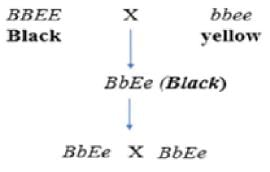
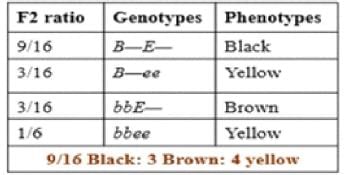


Two albino individuals marry and start a family. Their first child is normal in pigmentation. Is infidelity suspected and why/why not?- a)yes, albinism is recessive and neither parent carries a pigment gene
- b)no, albinism is dominant therefore at least one of the parents is a carrier
- c)yes, each parent has a different allele causing his or her albinism (genetic heterogeneity)
- d)cannot be determined from the limited information given
Correct answer is option 'C'. Can you explain this answer?
Two albino individuals marry and start a family. Their first child is normal in pigmentation. Is infidelity suspected and why/why not?
a)
yes, albinism is recessive and neither parent carries a pigment gene
b)
no, albinism is dominant therefore at least one of the parents is a carrier
c)
yes, each parent has a different allele causing his or her albinism (genetic heterogeneity)
d)
cannot be determined from the limited information given

|
Srishti Khanna answered |
Albino is an autosomal recessive condition but in this example, albino parents can have normal children if they have different mutated allele variants of albinism leads to complementation results in wild type pigmentation of the child.
In a cross between two F1 heterozygous tall plants, the F2 progeny consisted of tall and dwarf plants in the ratio 3 : 1. The probability that out of 7 plants chosen at random, 4 would be tall and 3 would be dwarf ______________ (answer upto 3 decimal points)
Correct answer is between '0.173,0.175'. Can you explain this answer?
In a cross between two F1 heterozygous tall plants, the F2 progeny consisted of tall and dwarf plants in the ratio 3 : 1. The probability that out of 7 plants chosen at random, 4 would be tall and 3 would be dwarf ______________ (answer upto 3 decimal points)

|
Vaibhav Ghosh answered |
Solution:
Given, in a cross between two F1 heterozygous tall plants, the F2 progeny consisted of tall and dwarf plants in the ratio 3 : 1.
Let T represent the allele for tallness and t represent the allele for dwarfism.
Thus, the genotype of the F1 heterozygous tall plants can be represented as Tt.
The cross between two F1 heterozygous tall plants can be represented as:
Tt x Tt
| |
Tt Tt
| |
TT Tt
| |
Tt tt
The F2 progeny consisted of tall and dwarf plants in the ratio 3 : 1.
Thus, the probability of getting a tall plant is 3/4 and the probability of getting a dwarf plant is 1/4.
We need to find the probability that out of 7 plants chosen at random, 4 would be tall and 3 would be dwarf.
This can be calculated using the binomial probability formula:
P(X = k) = (n C k)pk(1 - p)n-k
Where,
n = total number of trials = 7
k = number of successes = 4
p = probability of success = 3/4
q = probability of failure = 1/4 = 0.25
P(X = 4) = (7 C 4)(3/4)4(1/4)3
= (35)(27/256)(1/64)
= 0.1748 (approx.)
Therefore, the probability that out of 7 plants chosen at random, 4 would be tall and 3 would be dwarf is 0.1748 (approx.).
Given, in a cross between two F1 heterozygous tall plants, the F2 progeny consisted of tall and dwarf plants in the ratio 3 : 1.
Let T represent the allele for tallness and t represent the allele for dwarfism.
Thus, the genotype of the F1 heterozygous tall plants can be represented as Tt.
The cross between two F1 heterozygous tall plants can be represented as:
Tt x Tt
| |
Tt Tt
| |
TT Tt
| |
Tt tt
The F2 progeny consisted of tall and dwarf plants in the ratio 3 : 1.
Thus, the probability of getting a tall plant is 3/4 and the probability of getting a dwarf plant is 1/4.
We need to find the probability that out of 7 plants chosen at random, 4 would be tall and 3 would be dwarf.
This can be calculated using the binomial probability formula:
P(X = k) = (n C k)pk(1 - p)n-k
Where,
n = total number of trials = 7
k = number of successes = 4
p = probability of success = 3/4
q = probability of failure = 1/4 = 0.25
P(X = 4) = (7 C 4)(3/4)4(1/4)3
= (35)(27/256)(1/64)
= 0.1748 (approx.)
Therefore, the probability that out of 7 plants chosen at random, 4 would be tall and 3 would be dwarf is 0.1748 (approx.).
Compensation loop is formed when homologues of a chromosome pair. During which of the following events would a compensation loop form?- a)Deletion
- b)Inversion
- c)Duplication
- d)Translocation
Correct answer is option 'A,C'. Can you explain this answer?
Compensation loop is formed when homologues of a chromosome pair. During which of the following events would a compensation loop form?
a)
Deletion
b)
Inversion
c)
Duplication
d)
Translocation

|
Akshat Saini answered |
Deletion and duplication result in an unequal number of alleles on a homologue pair. This results in the formation of a compensation loop in both of these events.
Which of the following is true for a sex- influenced trait? - a)expression of a phenotype is not limited to any one sex
- b)It can be expressed in both males and females
- c)it is influenced by the hormone constitution of the person
- d)expression of a phenotype is limited to only one sex
Correct answer is option 'A,B,C'. Can you explain this answer?
Which of the following is true for a sex- influenced trait?
a)
expression of a phenotype is not limited to any one sex
b)
It can be expressed in both males and females
c)
it is influenced by the hormone constitution of the person
d)
expression of a phenotype is limited to only one sex

|
Abhishek Nambiar answered |
The expression of a phenotype is limited to one sex in a sex limited trait but is not true for a sex-influenced trait.
The probability of having a hemophilic baby if the mother is the carrier and the father is unaffected by this X-linked recessive disease will be _______ (Answer upto two decimal points)
Correct answer is '0.25'. Can you explain this answer?
The probability of having a hemophilic baby if the mother is the carrier and the father is unaffected by this X-linked recessive disease will be _______ (Answer upto two decimal points)

|
Srishti Kulkarni answered |
The mother will have genotype XX’ and father will be XY. The genotypes of their babies could be XX, XY, XX’ and X’Y. Only the male child will be affected. Therefore, the probability is ¼ or 25%.
Humans with Phenylketonuria develop light colored hair because of reduced hair pigmentation. This condition is an example of : - a)Epistasis
- b)Variable expressivity
- c)Variable penetrance.
- d)Pleiotropy
Correct answer is option 'D'. Can you explain this answer?
Humans with Phenylketonuria develop light colored hair because of reduced hair pigmentation. This condition is an example of :
a)
Epistasis
b)
Variable expressivity
c)
Variable penetrance.
d)
Pleiotropy

|
Milan Majumdar answered |
Phenylketonuria is an example of plieotropy in which mutation in a gene can cause multiple unrelated phenotypic symptoms and reduced hair pigmentation is one of them.
On basis of statements given below the mode of inheritance is
• Mostly males are sufferer of disease
• All male child developed from affected mother are diseased
• Female develope disease only when her father is diseased and mother is carrier- a)X-linked recessive
- b)X-linked dominant
- c)Autosomal dominant
- d)Autosomal recessive
Correct answer is option 'A'. Can you explain this answer?
On basis of statements given below the mode of inheritance is
• Mostly males are sufferer of disease
• All male child developed from affected mother are diseased
• Female develope disease only when her father is diseased and mother is carrier
• Mostly males are sufferer of disease
• All male child developed from affected mother are diseased
• Female develope disease only when her father is diseased and mother is carrier
a)
X-linked recessive
b)
X-linked dominant
c)
Autosomal dominant
d)
Autosomal recessive

|
Kiran Pillai answered |
It is not possible to determine the mode of inheritance based solely on the given statements. More information about the traits or conditions being discussed would be needed to determine the mode of inheritance, such as whether it is autosomal dominant, autosomal recessive, X-linked dominant, X-linked recessive, or multifactorial.
In Limnaea peregra, shell coiling is due to maternal effect. If the female parent is dextral (dd) and the male parent is sinistral (dd), the progeny would be- a)All dextral
- b)All sinistral
- c)Ratio of Dextral to Sinistral progeny would be 3 : 1
- d)Ratio of Sinistral to Dextral progeny would be 3 : 1
Correct answer is option 'B'. Can you explain this answer?
In Limnaea peregra, shell coiling is due to maternal effect. If the female parent is dextral (dd) and the male parent is sinistral (dd), the progeny would be
a)
All dextral
b)
All sinistral
c)
Ratio of Dextral to Sinistral progeny would be 3 : 1
d)
Ratio of Sinistral to Dextral progeny would be 3 : 1

|
Shivam Khanna answered |
Since both the mother and the father have genotype dd, the progeny would contain dd as well. Since the mother did not have a dominant allele, her gametes would not contain the protein required for dextral coiling of the shell in the cytoplasm although she herself had a dextrally coiling shell. Hence, they would all be sinistral.
Crossing two Drosophila flies with two different mutations yields almost all progeny with wild type traits. With this information, we can conclude that: - a)The genes are tightly linked.
- b)The genes are linked but are far apart.
- c)The genes are on two different chromosomes.
- d)Data is insufficient to conclude any of the above.
Correct answer is option 'C'. Can you explain this answer?
Crossing two Drosophila flies with two different mutations yields almost all progeny with wild type traits. With this information, we can conclude that:
a)
The genes are tightly linked.
b)
The genes are linked but are far apart.
c)
The genes are on two different chromosomes.
d)
Data is insufficient to conclude any of the above.

|
Kiran Pillai answered |
Introduction:
In this question, we are given that crossing two Drosophila flies with different mutations results in almost all progeny having wild type traits. Based on this information, we need to conclude whether the genes are tightly linked, linked but far apart, or on two different chromosomes.
Explanation:
To understand the possible conclusions, let's discuss each option one by one.
a) The genes are tightly linked:
If the genes were tightly linked, it would mean that they are very close to each other on the same chromosome. When two genes are tightly linked, they tend to be inherited together and do not assort independently during crossing over. In this case, crossing flies with two different mutations would not produce almost all progeny with wild type traits. Therefore, we can eliminate this option.
b) The genes are linked but are far apart:
If the genes were linked but far apart, it would mean that they are located on the same chromosome but at a considerable distance from each other. In this case, there would be a chance of crossing over occurring between the two genes during gamete formation. Crossing over can lead to the exchange of genetic material between homologous chromosomes. If crossing over occurs between the two genes, it can result in the production of recombinant progeny with different traits. However, since almost all progeny have wild type traits in this case, we can eliminate this option as well.
c) The genes are on two different chromosomes:
If the genes are on two different chromosomes, they would segregate independently during gamete formation. This means that the inheritance of one gene does not influence the inheritance of the other gene. In this case, crossing flies with different mutations can result in the production of progeny with wild type traits if the wild type alleles are dominant and present on both chromosomes. Therefore, this option is a plausible explanation for the observed results.
Conclusion:
Based on the information provided, we can conclude that the genes responsible for the mutations are on two different chromosomes (option c). This is the most likely explanation for the production of almost all progeny with wild type traits in the given cross.
In this question, we are given that crossing two Drosophila flies with different mutations results in almost all progeny having wild type traits. Based on this information, we need to conclude whether the genes are tightly linked, linked but far apart, or on two different chromosomes.
Explanation:
To understand the possible conclusions, let's discuss each option one by one.
a) The genes are tightly linked:
If the genes were tightly linked, it would mean that they are very close to each other on the same chromosome. When two genes are tightly linked, they tend to be inherited together and do not assort independently during crossing over. In this case, crossing flies with two different mutations would not produce almost all progeny with wild type traits. Therefore, we can eliminate this option.
b) The genes are linked but are far apart:
If the genes were linked but far apart, it would mean that they are located on the same chromosome but at a considerable distance from each other. In this case, there would be a chance of crossing over occurring between the two genes during gamete formation. Crossing over can lead to the exchange of genetic material between homologous chromosomes. If crossing over occurs between the two genes, it can result in the production of recombinant progeny with different traits. However, since almost all progeny have wild type traits in this case, we can eliminate this option as well.
c) The genes are on two different chromosomes:
If the genes are on two different chromosomes, they would segregate independently during gamete formation. This means that the inheritance of one gene does not influence the inheritance of the other gene. In this case, crossing flies with different mutations can result in the production of progeny with wild type traits if the wild type alleles are dominant and present on both chromosomes. Therefore, this option is a plausible explanation for the observed results.
Conclusion:
Based on the information provided, we can conclude that the genes responsible for the mutations are on two different chromosomes (option c). This is the most likely explanation for the production of almost all progeny with wild type traits in the given cross.
A disease is inherited to the next generation only through the mother. The inheritance will be- a)Autosomal dominant
- b)X-linked
- c)Autosomal recessive
- d)Organellar
Correct answer is option 'D'. Can you explain this answer?
A disease is inherited to the next generation only through the mother. The inheritance will be
a)
Autosomal dominant
b)
X-linked
c)
Autosomal recessive
d)
Organellar

|
Anushka Basak answered |
D) Organellar
Inheritance through the mother refers to the transmission of genetic material located in the mitochondria or other organelles within the cytoplasm of the egg cell. This type of inheritance is known as organellar inheritance, which is different from the traditional Mendelian inheritance patterns observed for nuclear genes.
Mitochondria are responsible for producing energy in the form of ATP, and they contain their own set of genes known as mitochondrial DNA (mtDNA). Unlike nuclear DNA, which is inherited from both parents, mtDNA is exclusively inherited from the mother. This is because during fertilization, the egg contributes most of the cytoplasm, including the mitochondria, to the developing embryo, while the sperm's mitochondria are usually eliminated.
Under normal circumstances, both males and females can inherit and pass on mitochondrial DNA to their offspring. However, if a disease-causing mutation occurs in the mitochondrial DNA, it can be passed on only through the mother. This is because sperm cells typically do not contribute mitochondria to the fertilized egg, and therefore, the father does not pass on his mitochondrial DNA.
The inheritance of mitochondrial diseases follows a unique pattern. Since only the mother can transmit the disease-causing mutation, affected individuals will always have an affected mother. In each generation, all the children of an affected mother will inherit the disease-causing mutation, while the offspring of an affected father will not be affected.
Examples of mitochondrial diseases include Leber's hereditary optic neuropathy (LHON), mitochondrial encephalopathy, lactic acidosis, and stroke-like episodes (MELAS syndrome), and mitochondrial myopathy, among others.
In summary, when a disease is inherited only through the mother, it suggests organellar inheritance, specifically involving the mitochondrial DNA. This mode of inheritance is distinct from autosomal dominant or recessive inheritance, as well as X-linked inheritance, which involve nuclear genes.
Inheritance through the mother refers to the transmission of genetic material located in the mitochondria or other organelles within the cytoplasm of the egg cell. This type of inheritance is known as organellar inheritance, which is different from the traditional Mendelian inheritance patterns observed for nuclear genes.
Mitochondria are responsible for producing energy in the form of ATP, and they contain their own set of genes known as mitochondrial DNA (mtDNA). Unlike nuclear DNA, which is inherited from both parents, mtDNA is exclusively inherited from the mother. This is because during fertilization, the egg contributes most of the cytoplasm, including the mitochondria, to the developing embryo, while the sperm's mitochondria are usually eliminated.
Under normal circumstances, both males and females can inherit and pass on mitochondrial DNA to their offspring. However, if a disease-causing mutation occurs in the mitochondrial DNA, it can be passed on only through the mother. This is because sperm cells typically do not contribute mitochondria to the fertilized egg, and therefore, the father does not pass on his mitochondrial DNA.
The inheritance of mitochondrial diseases follows a unique pattern. Since only the mother can transmit the disease-causing mutation, affected individuals will always have an affected mother. In each generation, all the children of an affected mother will inherit the disease-causing mutation, while the offspring of an affected father will not be affected.
Examples of mitochondrial diseases include Leber's hereditary optic neuropathy (LHON), mitochondrial encephalopathy, lactic acidosis, and stroke-like episodes (MELAS syndrome), and mitochondrial myopathy, among others.
In summary, when a disease is inherited only through the mother, it suggests organellar inheritance, specifically involving the mitochondrial DNA. This mode of inheritance is distinct from autosomal dominant or recessive inheritance, as well as X-linked inheritance, which involve nuclear genes.
In which case will the heterozygous individual (Aa) have a phenotype different from the homozygous dominant individual (aa)?- a)When the alleles do not show a dominant-recessive relationship.
- b)When one allele is incompletely dominant over the other.
- c)When the gene shows recessive epistasis
- d)When the two alleles are co-dominant
Correct answer is option 'A,B,D'. Can you explain this answer?
In which case will the heterozygous individual (Aa) have a phenotype different from the homozygous dominant individual (aa)?
a)
When the alleles do not show a dominant-recessive relationship.
b)
When one allele is incompletely dominant over the other.
c)
When the gene shows recessive epistasis
d)
When the two alleles are co-dominant

|
Siddharth Banerjee answered |
When alleles show a dominant recessive relationship, then the heterozygous and homozygous dominant genotypes show same phenotype. When alleles are co-dominant or incompletely dominant, the heterozygous individuals show different phenotypes such as in ABO blood groups and Antirrhinum flowers.
Suppose a mouse with a black coat breeds with an albino mouse and all of their offspring have a grey coat phenotype. What then does the gene for coat color in mice appear to be an example of?- a)Codominance
- b)Mosaicism
- c)Incomplete dominance
- d)Complete dominance
Correct answer is option 'C'. Can you explain this answer?
Suppose a mouse with a black coat breeds with an albino mouse and all of their offspring have a grey coat phenotype. What then does the gene for coat color in mice appear to be an example of?
a)
Codominance
b)
Mosaicism
c)
Incomplete dominance
d)
Complete dominance

|
Stuti Patel answered |
Since the genes for coat color do not show a dominant-recessive relationship and one gene is incompletely dominant over the other gene, they show a blended progeny. Thus, it is an example of incomplete dominance.
The brown allele for hair color (B) is dominant over the blond allele (b). If two brown-haired parents produce a child that is blonde haired, what is the approximate probability that at least one out of the next three children they produce will also have blonde hair?- a)20%
- b)42%
- c)75%
- d)65%
Correct answer is option 'B'. Can you explain this answer?
The brown allele for hair color (B) is dominant over the blond allele (b). If two brown-haired parents produce a child that is blonde haired, what is the approximate probability that at least one out of the next three children they produce will also have blonde hair?
a)
20%
b)
42%
c)
75%
d)
65%

|
Raghav Rane answered |
According to the question
B → Brown hair
b → bloude hair
The two mating partners are heterozygous
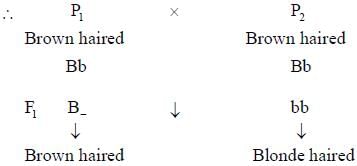
∴ Probability for a brown haired progeny (p) = 3/4
Probability for a blonde haired progeny (q) = 1/4
According to the question, at least one of the next three progenies have blonde hair. Therefore, following combinations of binomials will satisfy the condition-
(1) Only one progeny of the three has blonde hair
(2) Two of the three progenies have blonde hair
(3) All of them have blonde hair
Using binomial expression. the Probabilities of each possible combination can be calculated as
(1) n = 3 = Total progenies
x = 1 = No. of progenies with blonde hair
y = 2 = No. of progenies with blonde hair
p= 1/4 = Probability of having blonde hair
q = 3/4 = Probability of having brown hair
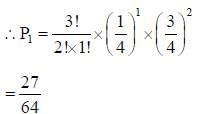
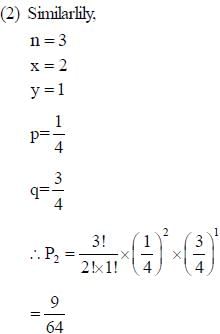
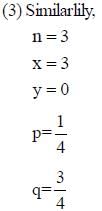
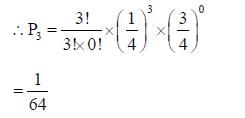
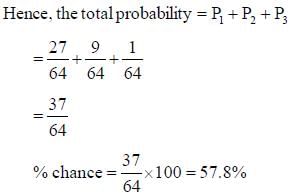
B → Brown hair
b → bloude hair
The two mating partners are heterozygous

∴ Probability for a brown haired progeny (p) = 3/4
Probability for a blonde haired progeny (q) = 1/4
According to the question, at least one of the next three progenies have blonde hair. Therefore, following combinations of binomials will satisfy the condition-
(1) Only one progeny of the three has blonde hair
(2) Two of the three progenies have blonde hair
(3) All of them have blonde hair
Using binomial expression. the Probabilities of each possible combination can be calculated as
(1) n = 3 = Total progenies
x = 1 = No. of progenies with blonde hair
y = 2 = No. of progenies with blonde hair
p= 1/4 = Probability of having blonde hair
q = 3/4 = Probability of having brown hair





Two siblings who inherit 50% of the genome from the mother and 50% from the father show lot of phenotypic differences. Which one of the following events during gametogenesis of the parents will maximally contribute to the difference?- a)Mutation
- b)Recombination
- c)Independent assortment
- d)Environment
Correct answer is option 'C'. Can you explain this answer?
Two siblings who inherit 50% of the genome from the mother and 50% from the father show lot of phenotypic differences. Which one of the following events during gametogenesis of the parents will maximally contribute to the difference?
a)
Mutation
b)
Recombination
c)
Independent assortment
d)
Environment

|
Anshul Mehra answered |
According to the Mendelian inheritance theory, during the gametogenesis, the assortment of the genes of one pair is independent to the other pair. Thus, each pair alleles behaves independently and does not influence the segregation of the other. As a result, each gamete receives one member of every pair of alleles in equal frequency with different sets of combinations. Hence, independent assortment results new combinations of character in the offspring showing lot of phenotypic differences in the siblings of the same parent.
Which of the following is not true for Klinefelter’s Syndrome?- a)It results due to trisomy of an autosomal chromosome.
- b)Males are usually sterile
- c)It is caused due to non-disjunction of chromosomes
- d)Females are usually sterile.
Correct answer is option 'A,D'. Can you explain this answer?
Which of the following is not true for Klinefelter’s Syndrome?
a)
It results due to trisomy of an autosomal chromosome.
b)
Males are usually sterile
c)
It is caused due to non-disjunction of chromosomes
d)
Females are usually sterile.

|
Anirban Kapoor answered |
Males are affected in Klinefelter’s syndrome. They have 2 X and 1 Y chromosome and are sterile.
Which of the following is not a true for an ideal population under the Hardy-Weinberg Equilibrium? - a)There should be few individuals.
- b)There should be random mating.
- c)It should be isolated from migration.
- d)There should be no selection.
Correct answer is option 'A'. Can you explain this answer?
Which of the following is not a true for an ideal population under the Hardy-Weinberg Equilibrium?
a)
There should be few individuals.
b)
There should be random mating.
c)
It should be isolated from migration.
d)
There should be no selection.

|
Sinjini Nair answered |
A large population size is necessary to accommodate rare phenotypes in the population which would otherwise go amiss.
In a polygenic trait, 4 gene pairs were involved. How many phenotypic classes would you expect in the F2 generation?- a)5
- b)8
- c)9
- d)16
Correct answer is option 'C'. Can you explain this answer?
In a polygenic trait, 4 gene pairs were involved. How many phenotypic classes would you expect in the F2 generation?
a)
5
b)
8
c)
9
d)
16

|
Mihir Singh answered |
Phenotypic classes are calculated as 2n+1, where n is the number of gene pairs controlling the trait.
Color blindness is an X-linked recessive trait. If a carrier mother and a color blind father have two children, then what is the probability that both the children will be male and both of them would be color blind?- a)50%
- b)25%
- c)6.25%
- d)12.5%
Correct answer is option 'C'. Can you explain this answer?
Color blindness is an X-linked recessive trait. If a carrier mother and a color blind father have two children, then what is the probability that both the children will be male and both of them would be color blind?
a)
50%
b)
25%
c)
6.25%
d)
12.5%

|
Sarthak Chavan answered |
To determine the probability of both children being male and both of them being color blind, we need to consider the genetic inheritance of color blindness, which is an X-linked recessive trait.
Explanation:
1. Inheritance of color blindness:
- Color blindness is caused by a mutation in the genes responsible for the perception of color, primarily located on the X chromosome.
- Since color blindness is an X-linked trait, it is more commonly observed in males because they have one X and one Y chromosome, while females have two X chromosomes.
- Males who inherit a single copy of the mutated gene will be color blind since they do not have a second X chromosome to compensate for the mutation.
- Females need to inherit two copies of the mutated gene to be color blind, as they have a second X chromosome that can potentially carry a normal copy of the gene.
2. Carrier mother and color blind father:
- A carrier mother has one normal and one mutated copy of the gene responsible for color vision on her two X chromosomes.
- A color blind father has two copies of the mutated gene on his X chromosome.
- The mother can pass on either her normal or mutated copy of the gene to her offspring, while the father can only pass on his mutated copy.
3. Probability of having male and color blind children:
- Since the father is color blind, he will always pass on his mutated gene to his male children.
- The mother, being a carrier, can pass on either her normal or mutated gene to her children.
- The probability of having a male child is 50%.
- The probability of passing on the mutated gene to a male child is 50%.
- Therefore, the probability of having both male children and both of them being color blind is 50% * 50% = 25%.
Thus, the correct answer is option 'b) 25%'.
Explanation:
1. Inheritance of color blindness:
- Color blindness is caused by a mutation in the genes responsible for the perception of color, primarily located on the X chromosome.
- Since color blindness is an X-linked trait, it is more commonly observed in males because they have one X and one Y chromosome, while females have two X chromosomes.
- Males who inherit a single copy of the mutated gene will be color blind since they do not have a second X chromosome to compensate for the mutation.
- Females need to inherit two copies of the mutated gene to be color blind, as they have a second X chromosome that can potentially carry a normal copy of the gene.
2. Carrier mother and color blind father:
- A carrier mother has one normal and one mutated copy of the gene responsible for color vision on her two X chromosomes.
- A color blind father has two copies of the mutated gene on his X chromosome.
- The mother can pass on either her normal or mutated copy of the gene to her offspring, while the father can only pass on his mutated copy.
3. Probability of having male and color blind children:
- Since the father is color blind, he will always pass on his mutated gene to his male children.
- The mother, being a carrier, can pass on either her normal or mutated gene to her children.
- The probability of having a male child is 50%.
- The probability of passing on the mutated gene to a male child is 50%.
- Therefore, the probability of having both male children and both of them being color blind is 50% * 50% = 25%.
Thus, the correct answer is option 'b) 25%'.
A Drosophila which has 2X chromosomes and 4 autosomes will be a- a)Female
- b)Male
- c)Metafemale
- d)Intersex
Correct answer is option 'B'. Can you explain this answer?
A Drosophila which has 2X chromosomes and 4 autosomes will be a
a)
Female
b)
Male
c)
Metafemale
d)
Intersex

|
Anushka Basak answered |
Explanation:
Drosophila is a genus of small flies, commonly known as fruit flies. They are widely used in genetics research as model organisms. In Drosophila, the sex of an individual is determined by the presence or absence of the Y chromosome, similar to humans.
- Females have two X chromosomes (XX), while males have one X and one Y chromosome (XY).
- Autosomes are non-sex chromosomes, and in Drosophila, there are four pairs of autosomes.
Based on the given information that the Drosophila has 2X chromosomes and 4 autosomes, we can determine its sex.
Explanation of options:
a) Female: Females in Drosophila have two X chromosomes (XX). This option is incorrect because the given Drosophila has 2X chromosomes, but we don't know the presence or absence of the Y chromosome to confirm the sex.
b) Male: Males in Drosophila have one X and one Y chromosome (XY). Since we know that the Drosophila has 2X chromosomes, it cannot be a female and must be a male. This is the correct answer.
c) Metafemale: Metafemales in Drosophila have three or more X chromosomes (XXX or more). Since the given Drosophila has 2X chromosomes, it cannot be a metafemale.
d) Intersex: Intersex individuals have atypical combinations of male and female characteristics. However, based on the given information, we cannot determine the presence or absence of the Y chromosome, which is necessary to determine if the Drosophila is intersex.
Conclusion:
Based on the given information, the Drosophila with 2X chromosomes and 4 autosomes is most likely a male.
Drosophila is a genus of small flies, commonly known as fruit flies. They are widely used in genetics research as model organisms. In Drosophila, the sex of an individual is determined by the presence or absence of the Y chromosome, similar to humans.
- Females have two X chromosomes (XX), while males have one X and one Y chromosome (XY).
- Autosomes are non-sex chromosomes, and in Drosophila, there are four pairs of autosomes.
Based on the given information that the Drosophila has 2X chromosomes and 4 autosomes, we can determine its sex.
Explanation of options:
a) Female: Females in Drosophila have two X chromosomes (XX). This option is incorrect because the given Drosophila has 2X chromosomes, but we don't know the presence or absence of the Y chromosome to confirm the sex.
b) Male: Males in Drosophila have one X and one Y chromosome (XY). Since we know that the Drosophila has 2X chromosomes, it cannot be a female and must be a male. This is the correct answer.
c) Metafemale: Metafemales in Drosophila have three or more X chromosomes (XXX or more). Since the given Drosophila has 2X chromosomes, it cannot be a metafemale.
d) Intersex: Intersex individuals have atypical combinations of male and female characteristics. However, based on the given information, we cannot determine the presence or absence of the Y chromosome, which is necessary to determine if the Drosophila is intersex.
Conclusion:
Based on the given information, the Drosophila with 2X chromosomes and 4 autosomes is most likely a male.
What fraction of the offspring will express one of the two dominant alleles, but not both in a cross of AaBb x AaBb?- a)9/16
- b)12/16
- c)1/8
- d)3/8
Correct answer is option 'D'. Can you explain this answer?
What fraction of the offspring will express one of the two dominant alleles, but not both in a cross of AaBb x AaBb?
a)
9/16
b)
12/16
c)
1/8
d)
3/8

|
Madhavan Iyer answered |
When the genotypes of all the progeny is listed, 6 out of 16 possible genotypes have either of the dominant alleles.
Blood group type A antigen is a complex oligosaccharide which differs from H antigen present in type O individuals by the presence of terminal- a)Glucose
- b)Galactose
- c)N-acetylgalactosamine
- d)Fucose
Correct answer is option 'C'. Can you explain this answer?
Blood group type A antigen is a complex oligosaccharide which differs from H antigen present in type O individuals by the presence of terminal
a)
Glucose
b)
Galactose
c)
N-acetylgalactosamine
d)
Fucose

|
Sagarika Yadav answered |
IA and IB alleles in human encode glycosyl transferase enzyme, each causing different modification in the terminal sugar of the H-structure (carbohydrate group) present on the surface of RBC. Addition of terminal N- acetylgalactosamine to the H-structure by IA allele results in A antigen and addition of terminal galactose by IB forms B antigen in human RBC, which is absent in the O type individuals.
What inheritance pattern does the pedigree chart show?
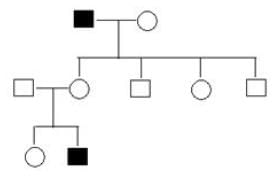
- a)X-linked dominant
- b)Autosomal recessive
- c)X-linked recessive
- d)Autosomal dominant
Correct answer is option 'C'. Can you explain this answer?
What inheritance pattern does the pedigree chart show?


a)
X-linked dominant
b)
Autosomal recessive
c)
X-linked recessive
d)
Autosomal dominant

|
Niti Mukherjee answered |
Since the trait skips a generation , it cannot be a dominant trait. Only the males are affected, so, it has to be an X-linked recessive inheritance.
Following is a hypothetical biochemical pathway responsible for pigmentation of leaves. The pathway is controlled by two independently assorting genes ‘A’ and ‘B’ encoding enzymes as shown below. Mutant alleles ‘a’ and ‘b’ code for non-functional proteins
 What is the expected progeny after selfing a plant with the genotypes AaBb?
What is the expected progeny after selfing a plant with the genotypes AaBb?- a)9 Green : 4 white : 3 yellow
- b)9 Green : 4 yellow : 3 white
- c)9 Green : 6 white : 3 yellow
- d)9 Green : 7 white
Correct answer is option 'A'. Can you explain this answer?
Following is a hypothetical biochemical pathway responsible for pigmentation of leaves. The pathway is controlled by two independently assorting genes ‘A’ and ‘B’ encoding enzymes as shown below. Mutant alleles ‘a’ and ‘b’ code for non-functional proteins


What is the expected progeny after selfing a plant with the genotypes AaBb?
a)
9 Green : 4 white : 3 yellow
b)
9 Green : 4 yellow : 3 white
c)
9 Green : 6 white : 3 yellow
d)
9 Green : 7 white

|
Sarthak Chavan answered |
The above cross can be illustrated as follows
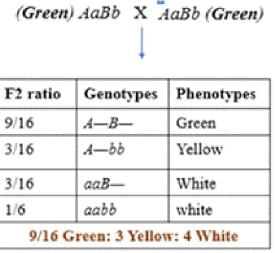

Which inheritance pattern does the following trait represents and the possible genotype of the father in the 2nd generation in the given pedigree chart?
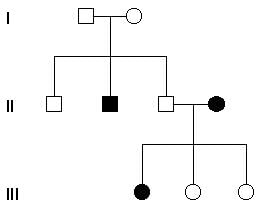
- a)Autosomal dominant, AA
- b)Autosomal recessive, Aa
- c)X-linked recessive, XY
- d)X-linked recessive, X’Y
Correct answer is option 'B'. Can you explain this answer?
Which inheritance pattern does the following trait represents and the possible genotype of the father in the 2nd generation in the given pedigree chart?


a)
Autosomal dominant, AA
b)
Autosomal recessive, Aa
c)
X-linked recessive, XY
d)
X-linked recessive, X’Y

|
Shilpa Datta answered |
The trait skips a generation and both males and females are affected by it. So it is most likely an autosomal recessive trait. Since the mother in the 2nd generation is affected by the trait, she would have the genotype aa. One of their children is also affected, so the father must be heterozygous for the trait i.e. Aa.
X chromosome inactivation- a)Causes Turner Syndrome
- b)Balances the X chromosome genes expressed in males and females
- c)Occurs only in females
- d)Is fatal to the embryos
Correct answer is option 'B,C'. Can you explain this answer?
X chromosome inactivation
a)
Causes Turner Syndrome
b)
Balances the X chromosome genes expressed in males and females
c)
Occurs only in females
d)
Is fatal to the embryos

|
Yashvi Roy answered |
Since females contain two X chromosomes, one X chromosome gets inactivated to prevent over-expression of genes in females and to balance the expression in males and females. Since only females contain an extra X chromosome, this happens only in females.
Chapter doubts & questions for Genetics - Mock Test Series of IIT JAM Biotechnology 2026 2025 is part of Biotechnology Engineering (BT) exam preparation. The chapters have been prepared according to the Biotechnology Engineering (BT) exam syllabus. The Chapter doubts & questions, notes, tests & MCQs are made for Biotechnology Engineering (BT) 2025 Exam. Find important definitions, questions, notes, meanings, examples, exercises, MCQs and online tests here.
Chapter doubts & questions of Genetics - Mock Test Series of IIT JAM Biotechnology 2026 in English & Hindi are available as part of Biotechnology Engineering (BT) exam.
Download more important topics, notes, lectures and mock test series for Biotechnology Engineering (BT) Exam by signing up for free.
Mock Test Series of IIT JAM Biotechnology 2026
7 docs|34 tests
|

Contact Support
Our team is online on weekdays between 10 AM - 7 PM
Typical reply within 3 hours
|
Free Exam Preparation
at your Fingertips!
Access Free Study Material - Test Series, Structured Courses, Free Videos & Study Notes and Prepare for Your Exam With Ease

 Join the 10M+ students on EduRev
Join the 10M+ students on EduRev
|

|
Create your account for free
OR
Forgot Password
OR
Signup on EduRev and stay on top of your study goals
10M+ students crushing their study goals daily










